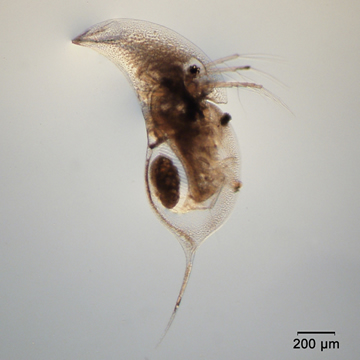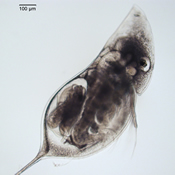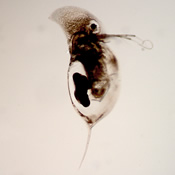| Ecology and Behavior | ||||
| Characteristics | ||||
|
||||
| Geographic Distribution | ||||
| Daphnia retrocurva range from temperate to glacial areas (3)(4). D. retrocurva distribution includes lakes in Washington, California, Montana, Minnesota, Wisconsin, Michigan, Texas (2), Northeast U.S.A.(3), Quebec (1), British Columbia (2), and other various areas of Canada (3). | ||||
| Reported Habitats | ||||
| Helmets form in warmer waters of temperate regions in summer (20-25° C) (5). D. retrocurva are commonly found in oligotrophic lakes (6). | ||||
| Food and Feeding Behavior | ||||
| D. retrocurva exhibits energetic "trade-offs" with helmet formation. Individuals with helmets have a slender carapace, reducing the filter chamber area and the filtering rate (1). | ||||
| Reproductive Habits | ||||
| Helmet-headed individuals carry fewer eggs than the round-headed ones due to energetic cost associated with producing a helmet (1). Ephippial resting eggs hatch into round-headed individuals with shorter shell spines in spring (1). These round-headed females produce larger clutch sizes (5-7 eggs) in spring due to better food conditions, larger brooding area in wider carapace and fewer predation threats (1). Round-headed D. retrocurva channel more energy into egg production; helmet-headed individuals, with smaller brooding area and clutch size, expend more energy swimming due to weight of helmet (1). In addition to helmet formation, lower food concentration in the summer may only allow for production of 1-2 eggs approximately every two days (1)(5). | ||||
| Predation on Daphnia | ||||
| Helmets are an advantageous anti-predatory device, especially in late spring to summer when predation by planktivorous fish and invertebrates is most intense (1). Although cyclomorphosis occurs in late spring, maximum helmet size is reached in mid- summer (1). The often transparent carapaces associated with helmets are a fish anti-predatory mechanism, making D. retrocurva less visible; the helmet extension makes the daphnid more difficult for invertebrate predators to handle and ingest (1). Acanthocyclops vernalis and Leptodora kindti prey upon D. retrocurva, but may be limited by helmet form (3). Predation by Chaoborus americanus is unaffected by D. retrocurva helmet size (3). |
||||
| Migration | ||||
| D. retrocurva exhibit normal (nocturnal) diel vertical migration, moving up at night and down during the day (6). | ||||
| Additional Pictures | ||||
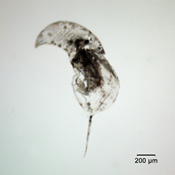 |
 |
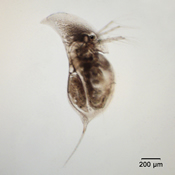 |
||
| References | ||||
|
(1) RIESSEN, H. P. 1984. The other side of Cyclomorphosis: Why Daphnia lose their helmets. Limnol. Oceanogr. 29: 1123-1127. (2) KISER, R. W. 1950. A revison of the North American species of the Cladoceran genus Daphnia. Seattle, Wa ., Edwards Brothers, Inc. p. 10. (3) HAVEL, J. 1985. Predation of common invertebrate predators on long- and short-featured Daphnia retrocurva. Hydrobiologia. 124: 141-149. (4) APPLEGATE, R. L. AND J. W. MULLER. 1967. Zooplankton standing crops in a new and old Ozark reservoir. Limnol. Oceanogr. 12: 592-599. (5) BROOKS, J. L. 1965. Predation and relative helmet size in cyclomorphic Daphnia. Proc. Natl. Acad. Sci. 53: 119-126. (6) STERNER, R. W. 1998. Demography of a natural population of Daphnia retrocurva in a lake with low food quality. J. Plankton Res. 20: 471-489. |
||||
